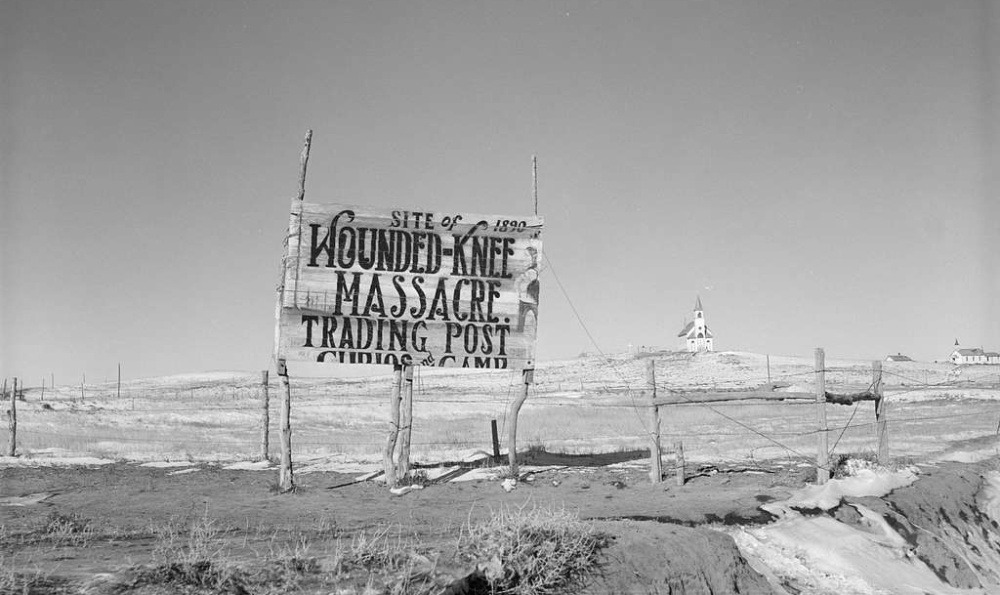In 1971, when Alvin Josephy wrote about the “Custer Myth” for Life Magazine, he included a photo of the mass burial at Wounded Knee in 1890, committed by the next generation of Custer’s 7th Cavalry. In a recent issue of Native News Online, Levi Rickert wrote about Secretary of Defense Pete Hegseth’s decision to NOT rescind the Medals of Honor awarded to 20 members of that cavalry unit for their actions in the 1890 massacre.
Indians had lobbied long and hard for a truth telling of the event and rescinding the medals of honor. They’d made progress. In 1990, on the 100th anniversary of the massacre, Congress passed a resolution expressing “deep regret” to the descendants of those killed at Wounded Knee. And there was hope that those Medals of Honor would go away.
With the Secretary of Defense’s decision, Rickert writes that Hegseth was not erasing woke politics and preserving real history, as he claimed, but “protecting a lie.”
“That lie — that what happened at Wounded Knee was a battle deserving of the nation’s highest military recognition — has been told for over 130 years. But Native Americans know the truth. It wasn’t a battle. It was a massacre. And it remains one of the most painful, unresolved wounds in American history.
“The soldiers of the 7th Cavalry were not heroes that day. They killed as many as 300 Lakota people — most of them unarmed women, children, and elders. They shot into tipis, chased survivors into ravines, and left bodies frozen in the snow. For this, the Medals of Honor were awarded. That is not courage. That is horror.”
So much good history has been discovered and revealed since Alvin Josephy wrote the real story of Custer’s debacle for Life in 1971. But, as confederate monuments find their ways back into “private parks,” and women and people of color are removed from the top ranks in the military, and the war on woke continues across the country, it is good to remember that true history will ultimately get told.
Our emboldened Native historians and journalists will not let Hegseth off the hook on this one. As my friend Bobbie Conner, Nez Perce-Cayuse director of the Cultural Institute on the Umatilla Reservation, says: it is hard to “unsee” things. It is up to all of us to make sure things stay “seen” as they really were and are.
Discover more from Post Alley
Subscribe to get the latest posts sent to your email.

I’m not sure what is gained by this move by Hegseth, as well as by Trump, in attempting to erase history as we know it. Historical knowledge is based on written accounts, period and event photographs, and numerous drawn illustrations. These people seem to believe that they can change our memories and our knowledge by a stroke of a pen. We all need to prove them wrong, as it turns out, with increased intensity and fortitude. When will Hegseth, et al, try to change our collective memories of the My Lai massacre? What’s next.
Thanks Rich for your powerful commentary on a horrific massacre of innocents by American troops and on the odious action of lethal War Master, misogynist, white supremacist, and neoConfederate Pete Hegseth. In failing to rescind Medals of Honor that were awarded US genocidaires as part of a political cover up, Hegseth again shaped history to the ends of the racist and lawless Trump regime. You probably know of these two excellent books, but wanted to recommend for readers: “Wounded Knee: Party Politics and the Road to an American Massacre” by rockstar historian Professor Heather Cox Richardson, an excellent study of the political machinations and the mass killing; and “Erasing History: How Fascists Rewrite the Past to Shape the Future” by Professor Jason Stanley, a chilling account of how authoritarians, like Trump, bend and whitewash history for political gain. Best wishes.
Hegseth has taken a rather creative alternative approach to the issue. Instead of rescinding the offending medals of honor, he has decided to solve the problem by simply degrading their value. He and Trump — with an able assist from Kristi Noem — are busily remaking the US armed forces into a banana republic personal militia. If they succeed, no respectable individual will want to receive one of their cheesy medals.
Yes, it’s certainly an oddly roundabout approach, no question about that. But so far it seems to be working.
Good writing: clear and insightful. One more chapter in another American version of mass killings and extermination of cultures, both of which we tried in Vietnam, in our schools and with slavery. When I lobbied for a Washington tribe and talked with members, two “themes” were apparent: 1. “Never forget” incidents like Wounded Knee, and 2. slot machines are the only “apology” they’ll ever get. My take on slot machines: enabling tribal casinos to have slot machines through the application of Danial Inouye’s Indian Gaming Regulatory Act has been perhaps the most successful American social program since enactment of Social Security. IGRA requires states to allows tribal casinos to have any type of gaming the state has: slot machines are nothing more than instant lotteries run by a central random number-generating computer. There must be some satisfaction among tribes that they can take money out of the pockets of nonmembers, both from gambling and alcohol consumption.